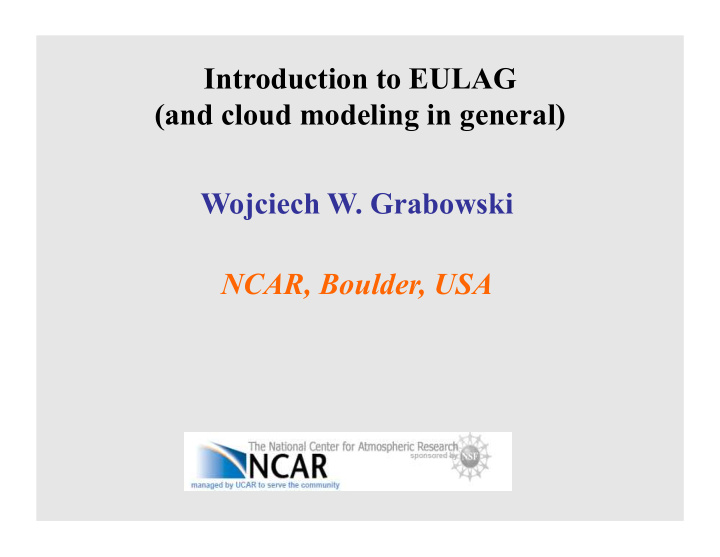



Introduction to EULAG (and cloud modeling in general) Wojciech W. Grabowski NCAR, Boulder, USA
SMALL-SCALE DYNAMICS: In the spirit of the Boussinesq approximation, moisture and condensate affect gas dynamics equations only though the buoyancy term p= ρ RT p’/p = ρ ’/ ρ + T’/T p~ 1000 hPa p’ ~ ρ u 2 ~ 1 hPa
T , q and Q – thermodynamics (and much more!)
Water vapor is a minor constituent: mass loading is typically smaller than 1%; thermodynamic properties (e.g., specific heats etc) only slightly modified; Suspended small particles (cloud droplets, cloud ice): mass loading is typically smaller than a few tenths of 1%, particles are much smaller than the smallest scale of the flow; multiphase approach is not required, but sometimes used (e.g., DNS with suspended droplets, Lagrangian Cloud Model) Precipitation (raindrops, snowflakes, graupel, hail): mass loading can reach a few %, particles are larger than the smallest scale the flow; multiphase approach needed only for very-small-scale modeling
Continuous medium approach: apply density as the main field variable (density of water vapor, density of cloud water, density of rainwater, etc…) In practice, mixing ratios are typically used. Mixing ratio is the ratio between the density (of water vapor, cloud water…) and the air density.
Mixing ratios versus specific humidities…
And we also need equation for the temperature:
And we also need equation for the temperature:
Modeling of cloud microphysics: solving a system of PDEs (advection/diffusion type) coupled through the source terms:
A very simple (but useful) model: rising adiabatic parcel… … by solving these equations. Take a parcel from the surface and move it up…
θ k+1 , q v k+1 , q c k+1 θ k , q v k , q c k The nonlinear equation for Δ q can be solved using the Newton-Raphson method …
F(x) = 0 x = ?
q v q c Look not only on the patterns (i.e., processes), but also on specific numbers (e.g., temperature change, mixing ratios, etc).
Invariant variables: total water, liquid water potential temperature, equivalent potential temperature.
Adding rain or drizzle:
We need something more complicated than a rising parcel as rain has to fall out. One possibility is to use the kinematic (prescribed flow) framework…
Cloud water and rain (drizzle) fields after 2 hrs (almost quasi- equilibrium…)
BabyEULAG documentation and code
Time to look at and run the code…
Recommend
More recommend